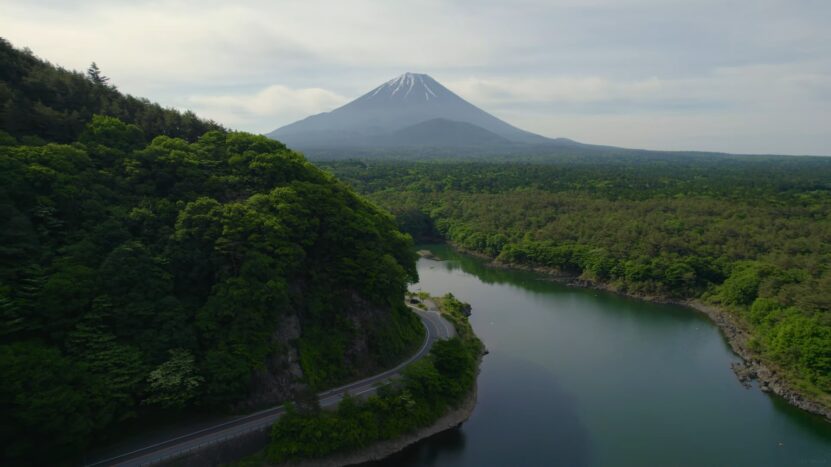The iconic Mount Fuji is a symbol of Japan. Standing tall and proud, this sacred site is the country’s most popular tourist attraction. The mountain is located about 62 miles (100 km) from Tokyo, making it easily accessible to travelers. On clear days, it’s even visible from the capital.
These interesting facts about Mount Fuji highlight the most interesting and important aspects of the mountain. From cool science facts about its makeup to information about climbing the mountain, you might just learn a few new things.
Whether you’re planning a trip to Japan, or you’re just looking to learn more about one of its most beautiful sites, hopefully, you’ll find these fascinating facts entertaining and educational.
10 Fun Facts
1. Mount Fuji is Technically an Active Volcano
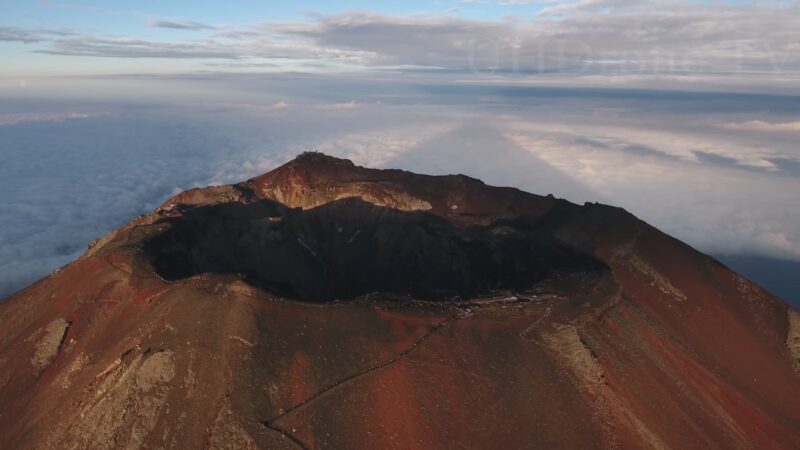
Although there is a lot of fiction mixed with fact in Konohana-no-sakuya-hime’s tale, we do know that Mount Fuji has been active for over 100,000 years and remained so until the late Heian Period. We also know that Mount Fuji is still technically active and it’s only a matter of time before it will erupt again.
We also know that any future eruption can and will cause chaos on roads, railways, and the skies because of the ash buildup.
Mount Fuji’s last eruption was the Hoei eruption, during the Edo Period. It started on December 16, 1707, and lasted until January 1, 1708. In those two weeks, most of the area surrounding the mountain was covered in ash — some places up to 3 meters deep — destroying crops and causing famines.
The accumulated ash caused landslides and flooding long after the initial eruption. Even Edo (now Tokyo) was blanketed in several centimeters of ash and tephra. So… don’t make Konohana-no-sakuya-hime angry.
The bottom layer is the Komitake volcano, then the Kofuji volcano, then Fuji, which is the youngest of the three.
2. Climbing Season

If you plan on climbing Mount Fuji the season is very short. Climbing season begins on the first day in July, and it ends in the last week of August on the 27th. This means the climbing season lasts less than two months.
During this time, the weather is generally milder and more predictable, and the climbing trails are open and staffed with guides and support services.
Climbing Mount Fuji outside of the official season is discouraged due to the increased risk of extreme weather conditions, lack of support services, and potential safety hazards. The mountain is also closed to climbers during the winter months due to heavy snow and ice.
It is important to note that climbing Mount Fuji can be a physically demanding and potentially dangerous activity, and climbers should be prepared with appropriate gear, supplies, and knowledge of the trails. Those with medical conditions or limited physical ability should consult with a doctor before attempting to climb.
3. A Large Part is Private Property

It is true that a large part of Mount Fuji is private property, owned by individuals, companies, or temples. This includes the land around the base of the mountain, which is used for farming and forestry, as well as the land along the climbing trails.
Despite the fact that the mountain is a symbol of Japan and a popular tourist destination, much of the land on and around Mount Fuji has been privately owned for centuries. This has led to various challenges for the local authorities and the government in terms of land use and preservation.
In recent years, efforts have been made to protect the natural and cultural heritage of Mount Fuji while also balancing the needs of the private landowners. The designation of Mount Fuji as a UNESCO World Heritage Site in 2013 has helped to raise awareness of the importance of preserving the mountain and its surrounding areas.
4. Women Used to be Forbidden to Climb Mount Fuji
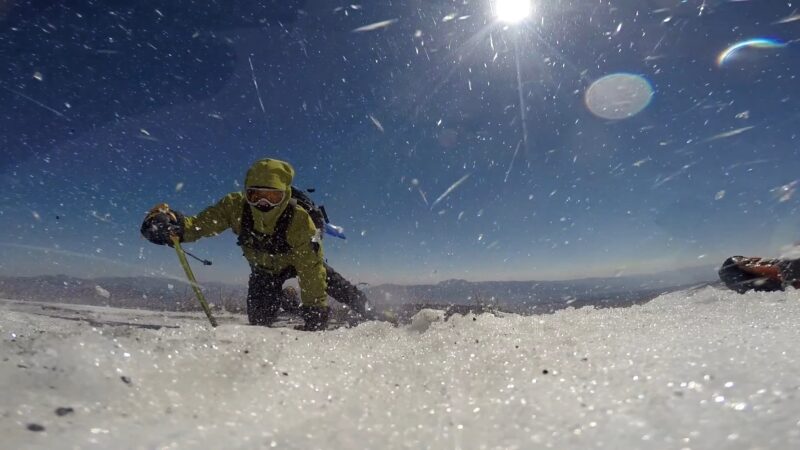
This ban was in place for several centuries, and it was not until the Meiji period (1868-1912) that the restriction was lifted.
The reasons for the ban are not entirely clear, but it is believed that they may have been related to religious or cultural beliefs that associated Mount Fuji with fertility and purity, which were traditionally seen as feminine qualities. Some also speculate that the ban may have been a way to limit the number of people attempting to climb the mountain, as it was considered a sacred site and the journey was seen as a spiritual pilgrimage.
Despite the ban, there were some women who attempted to climb Mount Fuji in secret, often disguising themselves as men or sneaking onto the mountain under the cover of darkness. It wasn’t until the 19th century, with the opening of Japan to the West and the influence of Western ideas, that attitudes towards women’s participation in outdoor activities began to shift, and the ban on women climbing Mount Fuji was eventually lifted.
Today, women are free to climb the mountain alongside men, and many thousands of people from all over the world make the journey each year.
5. First Person To Climb

It is not entirely clear who was the first person to climb Mount Fuji, as the mountain has been a sacred site and pilgrimage destination for centuries, and climbing it was not always seen as a record-breaking achievement. However, there are some historical records and legends that suggest early attempts to climb the mountain.
One of the earliest known attempts to climb Mount Fuji was made by a monk named En no Gyoja in the 7th century, who is said to have reached the summit after a seven-day journey. Another legend tells of a samurai named Hasekura Tsunenaga who climbed the mountain in the 17th century as part of a diplomatic mission to Europe.
The first recorded ascent of Mount Fuji by a non-Japanese person was made in 1868 by Sir Rutherford Alcock, a British diplomat who was serving as the British Consul-General in Japan at the time.
Alcock climbed the mountain along with a group of Japanese guides and described his experience in a book called “The Capital of the Tycoon.”
Since then, countless people from all over the world have climbed Mount Fuji, making it one of the most popular and iconic mountains to climb in the world.
6. Temperature
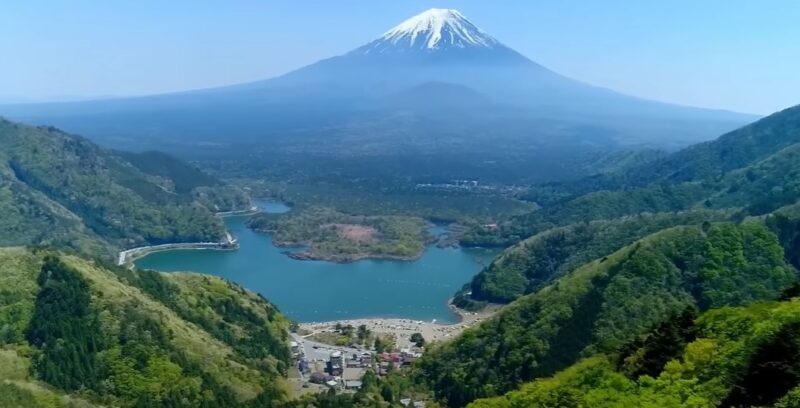
The temperature on Mount Fuji can vary greatly depending on the time of year and the altitude. During the climbing season, which typically runs from July to September, the temperature at the summit can range from below freezing to around 10°C (50°F), with temperatures becoming colder as altitude increases.
At the base of the mountain, temperatures can be much warmer, ranging from 20-30°C (68-86°F) in the summer months. However, it is important to note that weather conditions on Mount Fuji can be unpredictable, with sudden changes in temperature, wind, and precipitation.
Climbers should be prepared for a wide range of weather conditions, including cold temperatures, high winds, and rain or snow. It is recommended to dress in layers and bring appropriate gear, such as a waterproof jacket and pants, a warm hat and gloves, and sturdy hiking boots.
It is also important to check the weather forecast and trail conditions before embarking on a climb and to follow safety guidelines and regulations to ensure a safe and enjoyable experience on Mount Fuji.
7. Hotels

There are several accommodations available on and around Mount Fuji for those looking to stay overnight before or after their climb. Here are some options:
- Mountain Huts: There are several mountain huts located along the trails up Mount Fuji that offer basic accommodation for climbers. These huts typically have bunk beds or sleeping mats, communal dining areas, and basic toilet facilities. Reservations are recommended, especially during peak climbing season.
- Fifth Station Lodges: The Fifth Station is the starting point for most climbers, and there are several lodges located in the area that offer more comfortable accommodations, such as private rooms, hot springs, and restaurants. Some of these lodges also offer shuttle services to and from the mountain huts.
- Nearby Towns: There are several towns and villages located around Mount Fuji that offer a range of accommodations, from budget-friendly hostels to luxury hotels. Some popular towns include Fujinomiya, Kawaguchiko, and Yamanakako.
It is important to note that accommodations on and around Mount Fuji can be in high demand during peak climbing season, so it is recommended to book in advance to ensure availability.
Additionally, some accommodations may be closed during the off-season, so it is important to check availability and opening dates before planning a trip.
8. Mount Fiji Has a Symmetrical Shape

t is true that Mount Fuji has a symmetrical shape, with a near-perfect cone that is often used as a symbol of Japan. The mountain is approximately 3,776 meters (12,388 feet) tall and is located on the island of Honshu in Japan.
The symmetrical shape of Mount Fuji is a result of its volcanic origins. The mountain is actually made up of three separate volcanoes that have merged together over time, forming the distinctive cone shape that we see today. The outer slopes of the mountain are covered in a thick layer of ash and volcanic debris, while the summit is capped with snow for much of the year.
Mount Fuji is not only known for its symmetrical shape but also for its cultural significance and natural beauty. It has been a pilgrimage site for centuries and is considered a sacred mountain in Japanese culture. Today, it is a popular destination for climbers and tourists from all over the world who come to admire its beauty and experience its spiritual power.
9. 36 views

“36 Views of Mount Fuji” is a famous series of woodblock prints created by the Japanese artist Katsushika Hokusai in the early 19th century. The series consists of 36 individual prints that depict Mount Fuji from various vantage points and in different seasons and weather conditions.
Each print is a work of art in its own right, featuring intricate details and vivid colors that capture the majesty and beauty of Mount Fuji. Some of the most famous prints in the series include “The Great Wave off Kanagawa,” which features a towering wave in the foreground and Mount Fuji in the background, and “South Wind, Clear Sky,” which shows Mount Fuji rising above a field of flowers.
The “36 Views of Mount Fuji” series is considered one of the masterpieces of Japanese art and has been widely reproduced and imitated over the years. It has also had a significant impact on Western art, particularly on the Impressionist and Post-Impressionist movements, which were inspired by its bold compositions and vibrant colors. Today, the prints are considered a valuable cultural and artistic treasure and are on display in museums and private collections around the world.
10. Lakes Surrounding the Mountain
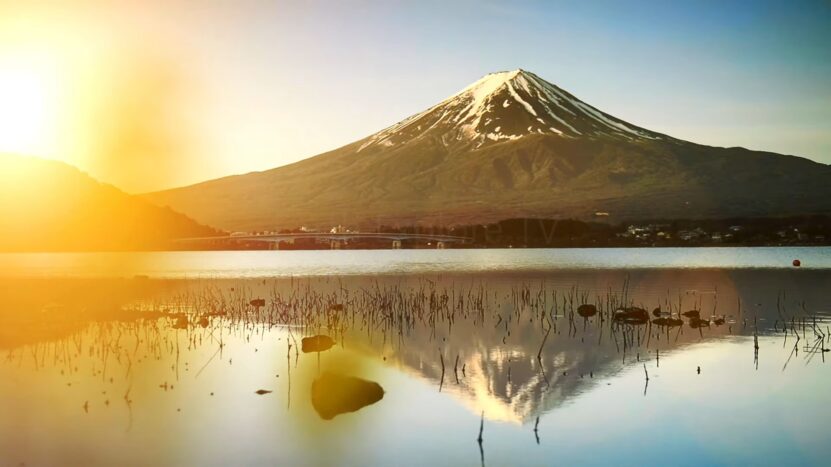
There are five main lakes that surround Mount Fuji, known as the Fuji Five Lakes. They are located on the northern side of the mountain and are popular tourist destinations in their own right.
- Lake Kawaguchi: This is the largest and most famous of the Fuji Five Lakes, and it offers stunning views of Mount Fuji from its shores. The lake is also a popular spot for boating, fishing, and hiking.
- Lake Yamanaka: It is the second largest of the Fuji Five Lakes and is known for its clear waters and beautiful scenery. Visitors can enjoy fishing, boating, and hiking in the area.
- Lake Sai: This is the smallest of the Fuji Five Lakes, but it offers a peaceful and serene setting for visitors to enjoy. The lake is surrounded by lush forests and is a popular spot for camping and hiking.
- Lake Shoji: The least developed of the Fuji Five Lakes and offers a more secluded and natural setting for visitors. The lake is popular for fishing and hiking.
- Lake Motosu: Are the westernmost of the Fuji Five Lakes and is known for its crystal-clear waters and beautiful sunsets. Visitors can enjoy boating, fishing, and hiking in the area.
FAQs
Is Mount Fuji Lucky?
Mount Fuji is considered a symbol of good luck and fortune in Japanese culture. It is believed that the mountain has spiritual and mystical powers that can bring blessings and good fortune to those who climb it or simply gaze upon it.
In traditional Japanese religion, Mount Fuji is seen as a sacred mountain that is home to numerous kami, or Shinto deities, who are believed to bring good luck and protection to those who worship them. It is also believed that climbing Mount Fuji during the summer months can bring good luck and prosperity for the coming year.
In addition to its spiritual significance, Mount Fuji is also seen as a symbol of national pride and identity in Japan. Its iconic shape and beauty have inspired artists, poets, and writers for centuries, and it is a beloved symbol of Japanese culture around the world.
Why Mount Fuji is Blue?
Mount Fuji is not actually blue in color. However, there is a phenomenon known as “Aka Fuji” or “Red Fuji,” where the mountain appears to be tinged with a reddish or orange hue during sunrise or sunset.
This effect is caused by the way that the sun’s light is refracted through the Earth’s atmosphere, which causes longer-wavelength colors (such as red and orange) to appear more prominent. This effect is especially pronounced at high altitudes, such as on the slopes of Mount Fuji.
The blue color that is sometimes associated with Mount Fuji may be due to atmospheric conditions or to the reflection of the mountain in nearby bodies of water, such as the Fuji Five Lakes. However, the mountain itself is not naturally blue in color.
What Animals Live on Mount Fuji?
Mount Fuji is home to a variety of animal species, ranging from small insects to larger mammals.
Here are some examples of animals that can be found on and around Mount Fuji:
- Japanese macaques: Also known as snow monkeys, these primates are native to Japan and can be found in the forests and mountains around Mount Fuji.
- Asiatic black bears: These bears are a subspecies of the black bear and are found throughout Japan, including on Mount Fuji.
- Japanese serow: This goat-like mammal is native to Japan and can be found in the forests around Mount Fuji.
- Japanese giant salamander: This is the largest salamander species in the world and is found in the rivers and streams around Mount Fuji.
- Kamoshika: This is a type of goat-antelope that is found in the forests around Mount Fuji.
- Various bird species: Mount Fuji is home to a variety of bird species, including eagles, hawks, owls, and woodpeckers.
- Insects: Mount Fuji is home to a variety of insects, including butterflies, beetles, and spiders.
Who Owns Mt Fuji?
Many naturally assume as a Mount Fuji fact that such an iconic mountain would be owned by the state. But the truth is, from the 8th stage and upwards.
Mt. Fuji is the private territory of Fujisan Hongū Sengen Taisha, which owns more than 1,300 temples around the island nation.
What God is Mount Fuji?
In Shintoism, which is the indigenous religion of Japan, Mount Fuji is regarded as a sacred mountain and is believed to be home to numerous kami, or Shinto deities. The mountain is known as Fujisan in Japanese, and it has been a place of worship and pilgrimage for centuries.
One of the main kami associated with Mount Fuji is Konohanasakuya-him, who is the goddess of Mount Fuji and the symbol of the mountain’s fiery power. She is also associated with the cherry blossom and is said to have a gentle and nurturing spirit.
Other kami associated with Mount Fuji include Sengen, who is the goddess of the mountain’s volcanic power, and Ninigi-no-Mikoto, who is a grandson of the sun goddess Amaterasu and is said to have descended from the heavens to establish Japan’s imperial lineage.
Final Thoughts
Japan’s national peak, Mount Fuji, is a UNESCO World Heritage site. Top destinations for nature lovers worldwide include it because of its alluring beauty and simplicity of access. It is understandable why Mount Fuji draws so many tourists each year.
Whether you wish to climb Mount Fuji or just want to see it up close to appreciate its majesty, hopefully, these fascinating facts about Mount Fuji have deepened your respect for the majestic mountain.
If you find this article useful, and you are interested in discovering more about different travel destinations, check out our other posts for more information and inspiration:
- 10 Best Resorts for Swiss Alps Snowboarding in 2023: Experience the Rush
- Top 10 Most Amazing Caves and Caverns in USA – Exploring the Depths
- Top 10 Interesting Arches National Park Facts: Experience the Beauty
- 10 Best Resorts for Swiss Alps Snowboarding in 2023: Experience the Rush
- 15 Interesting Trim Castle Facts – Ancient Irish Landmark

